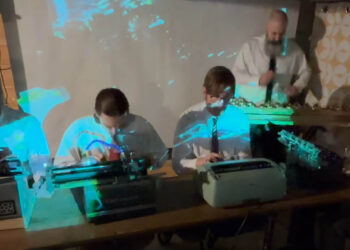The launch of author versions of TurnItIn and iThenticate have drawn plenty of flak, both here in the Kitchen and elsewhere, as they are expected to make it easier for plagiarists to cover their tracks. But there is another side to this issue: What if re-working of the language employed in past papers allows non-native English speakers to publish their high quality science in the journals their work deserves? Is it reasonable for journals to demand both immaculate English and a complete absence of plagiarism?
Kent’s post, the original by David Harrington, and the coverage on Inside Higher Ed all focus on the few rights and many wrongs of WriteCheck, the student-side version of TurnItIn, and its role in helping students prepare essays for course evaluation. Kent broadens his post to include iThenticate, which is widely used by journals to detect plagiarism by authors of submitted papers, as they have also launched an author-side service.
Whilst there are clear similarities between the two services, these two groups of authors deserve to be treated differently. Compared to a student essay, the level of technical writing expected for a journal submission is very high, and may in fact be beyond the capabilities of some researchers.
Furthermore, academic papers represent an incremental advance, and each manuscript needs to summarise the current state of the field before explaining how their data adds to that knowledge. It is therefore unsurprising that some authors use previously published papers to provide a framework for their own study, and then adapt the text accordingly.
Is this plagiarism? It almost certainly is. But what else can we expect when journals demand that papers are submitted in near perfect English? The intricacies of technical writing make it inevitable that authors will use text that already neatly expresses an idea rather than spend months or years trying to say it in their own words. The pragmatic approach in these instances is to demand that it’s not detectably plagiarized, and this currently means that the manuscript isn’t flagged up by plagiarism detection software like iThenticate.
By contrast, taking the tougher stance that plagiarism is an unforgivable academic offence is at odds with the notion that science is meritocratic and accessible to all researchers. We therefore must balance the need to credit the original work against the community’s need to access research that is otherwise held out by rigorous English language standards and strict anti-plagiarism rules.
Furthermore, although it’s easy to decry plagiarism in general, it’s much harder to decide where to draw the line in practice. The arrival of plagiarism detection services has meant that even trivial acts of copying can be detected, leaving journals with the headache of deciding whether to chase down every infraction or to just get on with the peer review process. The real benefit of these services to journals is finding papers with large contiguous sections of copied text, as allowing these to be published would have unfortunate consequences for both the author and the journal. After all, software cannot detect the more serious offence of using your own words to pass off others’ ideas as your own, and for this journals rely entirely on the diligence of editors and reviewers.
So where does the iThenticate service for authors and researchers fit into this? First of all, programs that allow authors to check for sections of their manuscript that have been copied from somewhere else are hardly illegal, and so even if pressure led iParadigms to withdraw its version, others would spring up in its place. They’re here to stay, whether we like it or not.
Second, coming back to the comparison with WriteCheck, students should always write essays as individuals, but authorship of papers submitted to scientific journals is typically shared among a number of different people. Since research authors all share responsibility for the submission, they are all guilty if the paper is plagiarized. Author-side plagiarism detection services offer authors a way to make sure that their names are not associated with a submission so egregious that it leads to sanctions from the journal for everyone involved.
If we take the pragmatic approach that the best we can hope for is not being able to detect copying, these author-side services are a blessing and not a curse. For example, iThenticate could continue to warn that the level of plagiarism was unacceptable until the author had fixed all the similarities. Furthermore, rather than just basing this warning on overall text similarity, it should also flag up phrases that contain too many contiguous borrowed words, and tell authors when their document contains too much text from just one or a few sources. These services could also offer to add citations — this at least ensures that the general idea is attributed to the original authors even if it is not directly quoted.
All in all, then, is it really fair to demand that papers submitted to journals are both in near perfect English and contain no trace of plagiarism? If those are indeed the expectations, then surely it’s more meritocratic to give authors the tools they need to improve their work instead of kicking away the ladder.
Discussion
5 Thoughts on "Plagiarism — The Great Leveler"
Tim,
Welcome to the Kitchen with your first stellar post. Grab a beer or a glass of wine.
You have uncovered the tension between the constructive nature of science and the value Western societies put on originality of thought as expressed in words. Add to it the fact that authorship in science is frequently collaborative and specialized although each author is somewhat accountable for the whole.
To add to your nuanced argument is that originality is more important in some sections of a scientific paper than others. A highly-repetitive Methods section is more tolerated than repetition in a Results or Discussion section.
Thanks Phil- I agree that it’s strange that plagiarism in some sections of the manuscript is more tolerable than in others. However, this does underline the idea that the grand crime is the theft of ideas, rather than the theft of words, as the intro and the discussion are the main places where the original hypotheses and interpretations appear.
I think it muddies the waters to refer to plagiarism here–or at least not to distinguish copyright infringement from plagiarism. As you admit, the software cannot really detect the latter reliably, but only the former. What counts as plagiarism goes well beyond copyright infringement and may be justified on grounds separate from what can be used to excuse–if anything can–copyright infringement. You seem to be justifying both in your post, but it would be more helpful to distinguish between the two in your arguments.
Hi Sandy,
Thanks for your comment- you’re absolutely right that I didn’t distinguish the two, but that’s largely because copying text and copying ideas both constitute the academic offense of ‘plagiarism’. Copying text does also infringe copyright, but it’s hard to imagine that journal editors would take any additional action over this- I’d be interested to hear if there have been lawsuits brought against authors of plagiarised papers on these grounds. I should stress that my intention was not to justify plagiarism, but to point out that it’s it’s a natural consequence of journals demanding high english standards from all authors.
How difficult is it to cite that a methodology section or any other section of another paper? The use of iThenticate should then be modified to show where an author needs to attribute correctly, not change their words to become better plagiarists.




